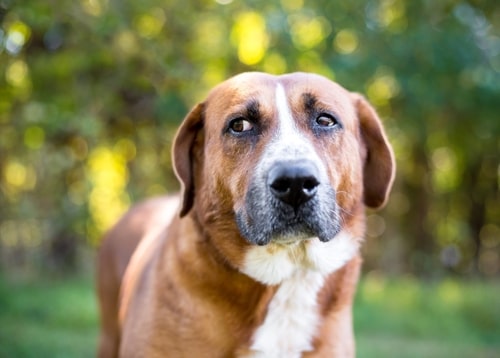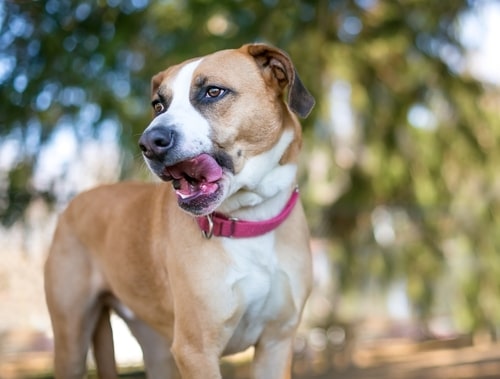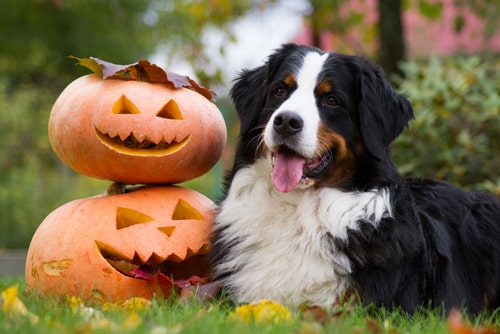
Fireworks & Halloween: Vet-Approved Tips to Help Your Dog Cope
Spotting the fear: Recognising stress in dogs
Tricks and treats to keep your dog calm
Keep calm and plan ahead
When it’s time to call the vet
Your Scary Season Toolkit

Fireworks & Halloween: Vet-Approved Tips to Help Your Dog Cope
October and November, the months of scary masks, garish decorations, flashing lights, and loud bangs, can be traumatising for dogs. Without the right support, their fear can escalate into significant stress and welfare issues.
This guide covers two essential topics: how to recognise when your dog is stressed, and practical ways to help them feel safe. With the right preparation, you can make the spooky season less scary for your pet.
Spotting the fear: Recognising stress in dogs
Dogs show stress in different ways. It helps to think of their reactions on a “stress scale”
Mild stress (“I’m not happy with this”):
Restlessness or increased alertness
Pacing, light panting (not due to heat or exercise)
Ears back
Hiding away for short periods
Increased yawning or lip licking
Poorer concentration
-
Looking around or away

Moderate stress (“This is getting scary”):
Panting, drooling, or trembling
Whining
Sustained pacing and refusing to settle
Being more clingy than usual
Trying to hide
-
Limited chewing, scratching or digging

Severe (“Get me out of here! Now!”):
Intense stress and panic
Destructive behaviour, including frantic attempts to escape and self-injury
Aggression towards the source of stress or redirected (to owner)
Continuous barking or howling
Complete withdrawal
Not eating or drinking
Physical symptoms (vomiting, diarrhoea, worsening of other illnesses)
Stress levels can increase or change over time, depending on exposure to the trigger. Spotting early warning signs means you have a chance to intervene before things start to escalate.
Tricks and treats to keep your dog calm
Tried and tested strategies that may help, depending on your dog’s stress level.
Mild stress
Create a safe space in a quiet room with blankets, toys, and water. Block out firework flashes with curtains or a crate cover.
Shut out scary sounds: close the windows and add TV or calming background music.
Try pheromone support like Adaptil Calm Diffuser or Collar. These mimic a mother dog’s reassuring scent (invisible to humans).
Offer puzzle toys, lick mats or chews to redirect attention from likely triggers.
-
Stick to regular routines and stay calm. Comfort your dog gently if they seek it, but avoid making too much of a fuss when they react.

Moderate stress
Make their den darker and safer with extra coverings.
Use a Thundershirt: The gentle pressure can reduce anxiety.
Try Adaptil Chews for fast-acting relief. Ideally, these should be started well before the fireworks season.
Use Adaptil Transport Spray for reassurance on bedding or crates when travelling.
Go for walks earlier in the day to expend excess energy when it’s safest.
Severe stress
Contact your vet: Prescription medication is often the safest option.
Double-check doors, windows, and fences to make sure they are secure. Ensure your pet’s microchip details are up to date in case of an unfortunate escape.
Ask about long-term desensitisation programmes with a behaviourist.
Keep calm and plan ahead
Be prepared
Start early: Install pheromone diffusers weeks before fireworks begin.
Make the safe place a familiar place: Familiarise your dog so they’re confident in their den.
Early dog-walks: Take your dog for a good walk or play session before dusk.
Offer food beforehand: Feeding your dog well before displays start can help them feel sleepier and more relaxed.
Managing trick-or-treaters
Keep your dog away from the front door to reduce stress.
Ask visitors to ring once rather than knocking repeatedly.
Have treats ready by the door: keep doorstep interactions to a minimum.
Better still: leave treats on the doorstep – sidestep the awful Halloween jokes and songs!
Be calmly supportive on the night
Chews and puzzles: Chewing releases “feel-good” hormones and provides distraction.
Soothing aids: Pheromone sprays, Thundershirts or calming chews give extra comfort.
Mirror calm: Dogs reflect our emotions, so stay relaxed.
Monitor closely: Watch for signs of escalating stress levels.
Never punish fear behaviours: It only makes anxiety worse.
When it’s time to call the vet
Sometimes, home strategies aren’t enough. Call a vet without delay for:
Aggression towards people or pets
Destructive behaviour, escape attempts or self-injury
Stress that lingers or worsens long after the event
Refusal to eat, sleep or toilet normally
Your vet can help with prescription medication or refer you to a registered animal behaviourist for an individual, structured desensitisation programme.
Your Scary Season Toolkit
Adaptil Calm Collar: Continuous calming support, ideal for dogs anxious on walks and at home.
Adaptil Calm Diffuser: Plug-in support for the home, best introduced before fireworks season.
Adaptil Chews: Fast-acting treats that take the edge off situational stress.
Adaptil Transport Spray: Quick reassurance for travel, car journeys, or crate bedding.
Thundershirt: A pressure vest that provides gentle, steady reassurance during fireworks or other stress triggers.
Final thoughts
With preparation, safe spaces, and calming aids, most dogs can get through fireworks and Halloween far more comfortably. Severe cases do need veterinary help, but early intervention makes all the difference.
Remember, your dog’s place on the stress scale can shift, so be ready with appropriate preventative tools and ‘treatment’ options. With your calming presence and the right support, the season of boos and bangs doesn’t have to be a nightmare for your furry friend.













